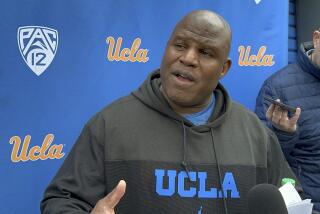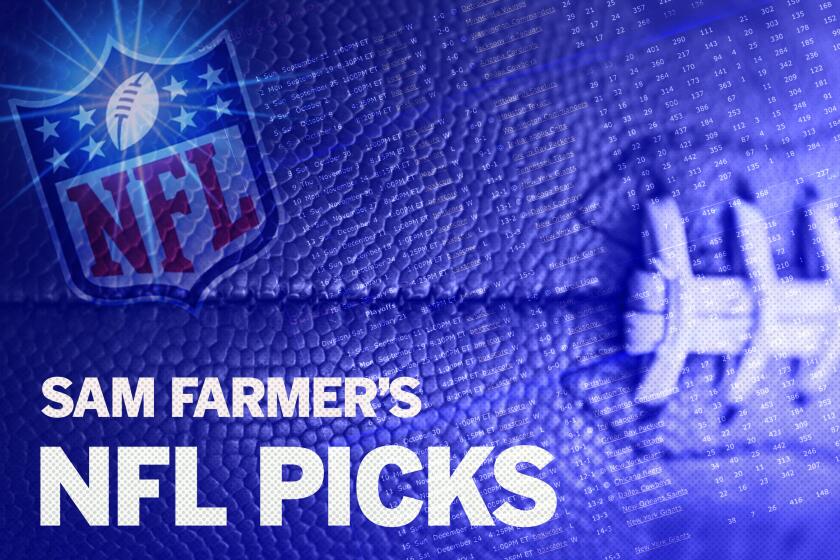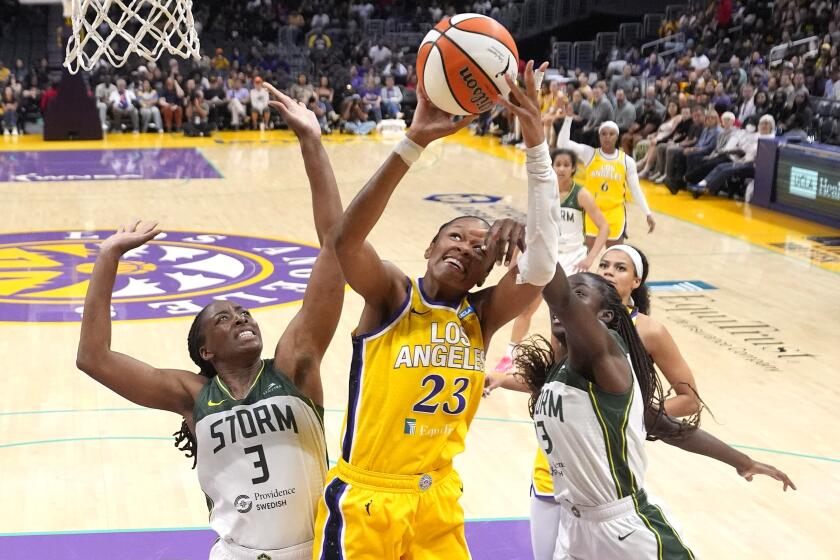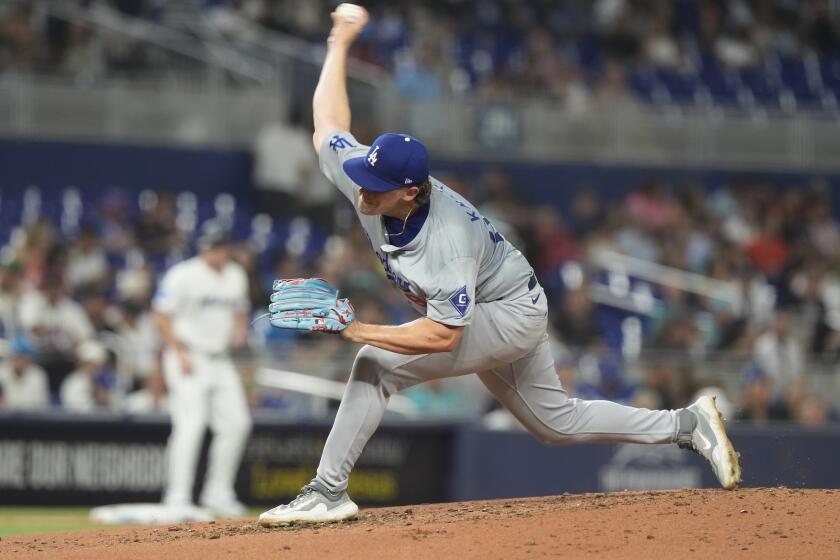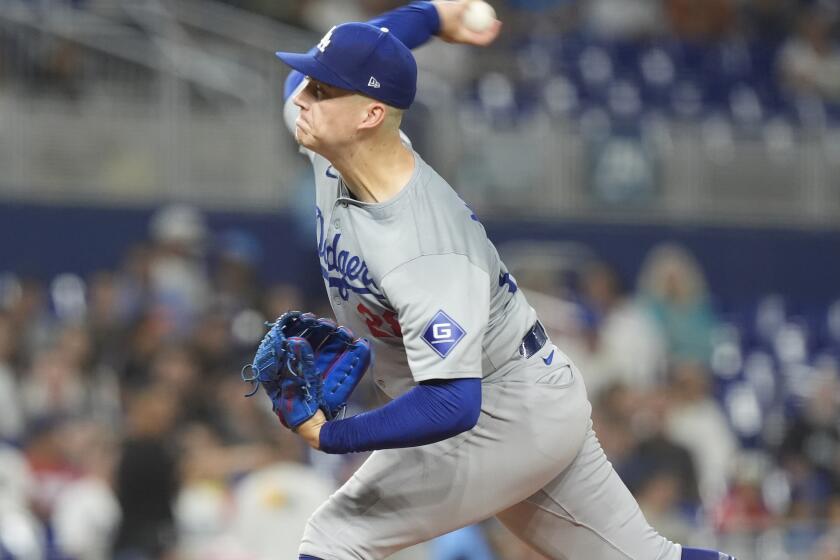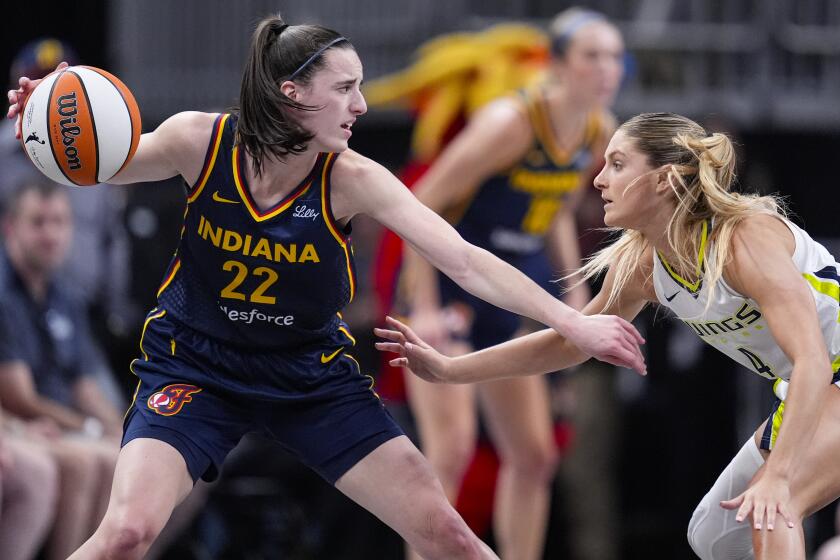49er Way Rings True in New Era : Pro Football: Walsh is gone but Seifert follows same blueprint to success in San Francisco.
The third round of the draft was coming up in 1979, and the San Francisco 49ers still didn’t have a quarterback.
They did have a promising new coach, Bill Walsh. And even then, before he ever lined up a team of his own in the National Football League, Walsh’s strong suit was appraising athletes.
“I think the kid at Notre Dame can help us,” he confided as his associates studied the roster of remaining candidates. “This is one of the two or three best quarterbacks in college football.”
Within the hour, Walsh made perhaps the finest third-round choice of all time, drafting Joe Montana--and launching a dynasty that is still alive and well, and confounding the sports fans who predicted a collapse when the 49ers changed coaches this year.
The surprise is that nothing else has really changed.
It’s still business as usual for the team that won the NFL championship 10 months ago, the 49ers’ third title since 1982. Consider:
--In the Walsh era, they won three Super Bowls and 101 other games in 10 years, leaving the rest of the league far behind.
--In the George Seifert era, still in a groove under a new coach, they have started 9-2.
Thus as Seifert heads the 49ers into next Monday night’s game of the year against the New York Giants (9-2), they’re right where they usually are on the NFL ladder: on top or up close.
Continuity of that kind is uncommon today in big-time sports.
A Super Bowl winner normally nose-dives within the year.
A coach replacing a legend normally falters spectacularly.
Indeed, when Walsh recommended Seifert for the job, NFL rivals smiled knowingly and said, “Goodby, 49ers.” They remembered the hand-picked successors to Vince Lombardi at Green Bay, John Robinson at USC, John Wooden at UCLA, and others. They remembered Alabama without Bear Bryant.
Is Seifert the explanation?
He is, in part. At 49, he’s a bright, stable, highly qualified veteran of 25 years in coaching. But Seifert hasn’t by any means done it alone.
First, the man who hired both Walsh and Seifert, owner Edward J. DeBartolo Jr., has built the NFL’s new model organization. As a success story, DeBartolo’s club has replaced Tex Schramm’s Dallas Cowboys and Paul Brown’s Cleveland Browns of earlier eras.
Second, almost everybody on the 49er payroll is out to show Walsh that the former coach isn’t needed anymore--everybody from DeBartolo and Montana on down. It’s a modern NFL truism, of course, that the same team can’t repeat as champion. But with a new coach, this isn’t the same team.
Third, and most significant, Walsh, the super talent scout, left the 49ers with a full deck. The strength of Seifert’s team is the gifted backup personnel that Walsh developed or brought in during his final years, when he put together a ballclub so sound and deep that it can go on winning without him.
This was done deliberately. After injuries ruined his first two Super Bowl champions in the follow-up seasons of 1982 and ‘85, Walsh changed priorities and began to:
--Force-feed 49er youngsters. That is, he kept more draft choices than he really wanted to, trained them more intensively, and used them in more games.
--Focus on depth. He upgraded his backup players at every turn, then benched his regulars at times to give the new guys game experience.
In other words, reasoning that you don’t need the best players in the league at any position, he went for the best backups at every position.
Montana, for example, doesn’t place among the top three salaried quarterbacks in football, but teammate Steve Young is the game’s only $1 million backup.
“Some first-string quarterbacks don’t make $1 million,” said John McVay, the 49ers’ administrative vice president.
On the entire squad, only one 49er leads the league in salary at his position--free safety Ronnie Lott.
More typical of the club is the double trouble at offensive left tackle, where the rotating residents are Bubba Paris and Steve Wallace. That’s about $800,000 for a left tackle.
“Some teams would trade one of them, and bring in an $80,000 backup,” McVay said.
The 49ers play with three interchangeable offensive guards, four interchangeable cornerbacks, three interchangeable wide receivers, and with similar prime moving parts elsewhere on both offense and defense.
At most positions, their second- and third-string personnel is the best and best paid in the league.
And in another season of crippling injuries here and throughout the league, the 49ers are winning with that depth.
Call it the DeBartolo way.
A MODEL OWNER
When the earth began shaking at Candlestick Park last month, Lisa DeBartolo, the proud possessor of a book of World Series tickets, had just pulled into the parking lot.
The oldest of the 49er owner’s three daughters, Lisa drove across from Oakland less than 15 minutes before a segment of the Bay Bridge collapsed.
“She couldn’t get to a phone that worked,” her father said. “Our other daughter, Tiffanie--they’re roommates at St. Mary’s (in Moraga)--was a little frantic when she called us in Ohio. Then we all went crazy.
“It was 2 1/2 hours before Lisa could phone Tiffanie that she was safe. Let me tell you--there are easier ways to spend 2 1/2 hours.”
Eddie DeBartolo is known as a family man. Nothing is too good for his daughters.
And, apparently, nothing is too good for what he calls his other family, the 49ers.
“With Eddie, you go first-class all the way,” Montana said, noting that, on the road, the 49ers stay in top hotels, with each veteran in a room of his own.
Aloft, the club moves about only in wide-body jets, providing two or three seats for each player. And at mealtime, they all get first-class dinner trays.
“Eddie was here before Bill Walsh or any of us were here,” Montana said. “He had some tough years at first (hiring four coaches in four years, all losing seasons). But he learned how to win.”
A tough little businessman--cordial but projecting great confidence--DeBartolo, 43, is one of the league’s most obviously self-assured new owners, having stepped forward this year in the faction that overturned the Establishment candidate for commissioner, Jim Finks.
In fact, DeBartolo was the first to get visibly wrought up at Palm Desert last March when the old guard packed the search committee.
The 49er owner in his other life is a Youngstown (Ohio) shopping mall magnate whose namesake father, according to Forbes magazine, built the nest egg up to $1.4 billion this year. They’re the richest NFL family, just ahead of the Washington Redskins’ Jack Kent Cooke and son, who have $1.25 billion.
So Eddie can afford the expensive backup players that Walsh wanted and Seifert wants--including former Raider linebacker Matt Millen.
“In the short time I’ve been here, the thing that’s struck me is the way they go out and get anything they need,” Millen said.
Among other things, DeBartolo unblinkingly meets the NFL’s largest payroll, rendering it impossible for his club to show a profit.
He has spent his 13 years in San Francisco perfecting the formula that makes him the NFL’s owner of the ‘80s: Instead of throwing money around like any other billionaire, he goes after good, sound advice. Then he throws it around.
One result: Three Super Bowl rings.
“You can only win on the pro level with real professionals,” he said, identifying 49er front-office leaders Carmen Policy, Keith Simon, McVay and others, coaches Walsh, Seifert and others, and Montana and the other players.
“And you have to treat them like the friends they get to be,” DeBartolo said. “You have to treat them like gentlemen.”
Among the players, he is possibly the most popular NFL owner.
“I think the players sense that I deeply care about them,” he said.
Montana made the same point and added: “You want to give something back to a person like that. Christmas is coming--but what can you do for a man who has everything? The only thing you can give back is to win.”
A LIVE LEGEND
If the 49ers are a family to DeBartolo, they seem more like a family business to others.
They’re like a family business that has lost its white-haired patriarch to a heart attack, or to a job in TV-land--something incapacitating.
And now the sons have taken over.
The sons are Montana, Lott, Seifert, DeBartolo and the others who have determined not to give the store away but to make it grander than ever.
For example, 49er receivers are still getting open with plenty of room to spare, the way the patriarch planned it so long ago. Wide-open receivers are a 49er trademark. Why is that?
Here are two answers:
“It’s built into the system,” said a 49er aide, Dave Rahn. “The five (eligible) receivers take off on mostly shorter patterns, and they accelerate in five different directions at once. They don’t get into foot races with defensive backs, who are usually all faster. They just try for quick separation.”
Said Seifert: “When (Walsh) was starting out as a coach, he didn’t have a lot of great players. He had to find a way to move the ball with what he had--a way to get the job done. Then he found that this is really the best way.”
Aside from differences in pass-offense philosophy, how does the 49er way differ from the Raider way?
“There are some similarities and some differences,” said linebacker Millen, who was a Raider standout for years. “The biggest difference is that the Raiders encourage cheating down there, which we thought of as kind of funny.
“The Raiders will do anything to win: grab a guy by the throat, jam him (illegally), fight him, yell at the other coaches.
“Here, as a 49er, you play your game, play as hard as you can, and let the score take care of itself.”
Millen is still an Al Davis booster.
“For years, (Davis) paid me as well as any linebacker in the country, and I appreciate that,” he said.
But he was shocked by the reverent tones the 49ers reserve for Walsh.
“They talk about him as if he’s Moses looking down from the mountain,” Millen said.
Norb Hecker, the former Ram star who has been with the 49ers for many years, concluded long ago that what lifted Walsh above other coaches was his gift for talent evaluation.
“He was the greatest personnel scout of his time because he was interested in it, and worked at it,” Hecker said.
“I remember the day Bill went down to Clemson to scout a quarterback, Steve Fuller, but forgot all about Fuller when he saw a big receiver that nobody had ever heard of, Dwight Clark. We don’t win our first Super Bowl without Dwight Clark. We aren’t even in it.”
Clark, like Walsh, is gone now. But another of the patriarch’s hand-picked stars, Jerry Rice--who in 11 games this year has already caught an improbable 14 touchdown passes--is still around.
And so the melody lingers on.
“Bill and I worked together, here and at Stanford, for 11 years,” Seifert said. “I was with him when he put (the system) in. I had a hand in it. I believe in it. Why should I change it?”
COMEBACKS, TOO
Watching Joe Montana throw passes, Walsh once said, is like watching Rembrandt paint.
If the 49ers are the team of the ‘80s, Montana is the quarterback of at least the decade, perhaps of all time. For one thing, statistically, he is the highest-rated passer ever.
The way that Montana does it, however, has always been more impressive than his statistics.
He does it with the grace of a National Basketball Assn. player, which he has always wanted to be, and would be, if he were a few inches taller. He went to Notre Dame to play basketball. His passing motion developed out of his jump shot.
As the main link between the Walsh and Seifert eras, Montana is playing his best football this year.
The change is in his consistency. In his younger NFL years, he played a lot of big games for his first coach, including three Super Bowl games, but there were days when he could have done more.
For the new coach, Montana has been a study in near perfection--even Sunday, when the 49ers lost to Green Bay because they were a tick off in their timing.
The difference in the two Montanas seems to be in the motivation. Along with many other great athletes, the 49er quarterback, though an intense competitor, has often seemed to need some prompting.
Walsh thought so, in any case, even threatening last season to give the job to another man, Steve Young.
It was almost too late--the 49ers were a shaky 6-5 in the standings last November--when they finally got Montana going. After that, they won seven of their last eight, including the three big ones in the playoffs.
This year, Seifert has shrewdly left the motivation of Montana up to Montana, who, understandably enough, only wants to demonstrate that as much as he owes to Walsh, he can do it without him.
Just as understandably, Montana is uncomfortable talking about it.
“(The offense) is simply executing better this year,” he said, explaining his fast start. “In the past, we’ve been up and down--the defense was the mainstay. This year (the offense) is steadier.
“We’re getting more out of (receiver John Taylor) and (fullback Tom Rathman). You can’t just sit back and cover Rice and (halfback Roger Craig) this year. You have to worry about a lot of people now.”
Still, in football, everything starts at quarterback, and the scary question for 49er fans is: How much longer will we have Montana?
“Forever,” he said, smiling. But he is 33. He is the senior 49er. He is the only player left from the difficult days of ’79 when he and Walsh were rookies together. And he is only three years removed from the day he broke his back.
In historical terms, Montana’s surgery that time, climaxing his most serious of many football injuries, merely set up his greatest comeback. His comeback total, incredibly, is 25. There were six stirring fourth-quarter comebacks at Notre Dame, then 15 more in his first nine pro years, followed by three more this season.
When you throw in the back--noting that Montana was absent a bare six weeks after spinal surgery and threw three touchdown bombs, all to Rice, in his first game back--you’ve got a story that no one will believe when you tell it in 2002.
Unless Montana is still here, which is possible.
“In the NFL, you can’t beat the hours,” he said. “Six months on, and six months off. They’ll have to kick me out.”
SOMETHING NEW
A quarter-century ago, when George Seifert proposed marriage to Linda Miller, she agreed, on one condition.
“I’d like a special honeymoon,” she said. “I want you to take me hiking.”
“Hiking?” he said. “Where?”
“I want to spend a June week in Yosemite Valley,” she said.
As George tells it now, he didn’t complain.
“The price was right,” he said at his new office last week. “We carried sleeping bags, and camped out under the stars and the mosquitoes.”
Since their big week at Yosemite, the Seiferts have spent much of their married life outdoors, George as a deep-sea fisherman and boar hunter. He hunts boar on horseback.
Linda, mother of daughter Eve and son Jason, would still rather walk. Somewhere. Anywhere. Last August, in the week of the Ram-49er exhibition game in Tokyo, she climbed Mt. Fuji.
“Because it was there,” she dutifully said afterward.
It has been nine months since the head of the family started up another kind of mountain as the 12th head coach of the 49ers. He turned 49 at the Super Bowl. Until Walsh retired after coaching the team from age 48 to 58, Seifert was, basically, just another anonymous San Francisco native.
Oldest of three sons of a Mission District teamster, Seifert has, in his lifetime, left the Bay Area only briefly, and never with real gusto, once to play guard and linebacker at Utah, once to coach Cornell.
He was asked what he learned in the Ivy League during his only two previous seasons as a head coach.
“Not to try to do everything yourself,” he replied promptly. “To have faith in your players.”
That’s a philosophy that is about to be severely tested. So is Seifert’s patience, which he strengthened in years of driving a little boat around a big ocean, looking for a salmon steak swimming by.
He is being compared to Walsh every day. He even looks something like him. They are similarly slender and gray, though Walsh is whiter on top and Seifert projects more anger, probably unintentionally.
On the sideline, to one critic, Seifert resembles an angry bird of prey.
To most observers, the two old friends are drastically different types. Seifert is fundamentally unassuming, Walsh fundamentally enigmatic.
“(Seifert) reminds me of Tom Flores,” Millen said, naming his old Raider coach. “If you’re doing it right, they leave you alone.”
On the job, “I’m more spontaneous,” Seifert said. “(Walsh) is more calculating.”
One day in 1987, as the 49ers’ defensive coach, Seifert lost his temper during a halftime meeting at Soldier Field and impulsively kicked a chalkboard halfway across the locker room, breaking his toe.
The 49ers went on to win, but Seifert, limping and in pain, didn’t really enjoy it.
Comparing the new coach to his predecessor, San Francisco Chronicle writer Ira Miller said: “If Walsh were going to kick a chalkboard at halftime, he would have practiced to make sure he didn’t hurt himself.”
The Seifert residence is down the peninsula in middle-class Sunnyvale. From the 49ers’ luxurious, new $10-million practice facility at Santa Clara--where owner DeBartolo’s big office has a genuine pigskin leather floor--the new coach goes home each night to the same small three-bedroom ranch-style house that he moved the family into 12 years ago.
He worked at Cornell between Stanford tours, and when he came back, he couldn’t afford Palo Alto, he said.
Unlike some assistant coaches, however, he also bought a second house several years ago. He found it at Bodega Bay, two hours north. It’s a typical, comfortable bay house overlooking the marina where he berths his 22-foot fishing boat, the Happy Hooker.
On their last visit last June, before football interrupted their pleasant early-summer outdoor life style, Linda, as usual, hiked about the bay, and George fished it strenuously, nearly drowning one night.
He’s the kind who plays as hard as he works. But despite his work ethic, he will have a tough time winning this season, personally, regardless of whether the 49ers win.
The best he could hope for on a Super Bowl ring--if the club even gives him one--is an inscription reading, “He didn’t screw it up.”
More to Read
Go beyond the scoreboard
Get the latest on L.A.'s teams in the daily Sports Report newsletter.
You may occasionally receive promotional content from the Los Angeles Times.


